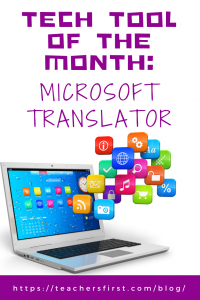 This month’s tech tool gives a voice to all students. I am so excited to share Microsoft Translator. This is a FREE tool that is available on all platforms (as an app or using a web browser). If you are using the Edge browser, there is also a plug-in option! With the final week of September being the International Week of the Deaf, there is no better time to share this multi-functional tool.
This month’s tech tool gives a voice to all students. I am so excited to share Microsoft Translator. This is a FREE tool that is available on all platforms (as an app or using a web browser). If you are using the Edge browser, there is also a plug-in option! With the final week of September being the International Week of the Deaf, there is no better time to share this multi-functional tool.
As the name implies, Translator will translate your words: both speech and text. There are countless language options when using text: over sixty languages! The speech option on Translator is currently available for twelve languages: German, Spanish, French, English, Arabic, Chinese, Japanese, Russian, and more.
The best part of this tool is how simple it is to use. There are two ways to use this tool. First, is the text translator. For this, you need only to copy and paste your text (or a URL) into the first box. Then click “translate.” The Translator tool will convert your text into the language of your choice. (Did I mention that there are over sixty language options!)
The second way to use Microsoft Translator is simply amazing and a true game-changer! This option allows you to converse with individual students or groups in your choice of language. Start by clicking “start conversation.” Next, enter your name and the language choice. You are provided with a code to share with your participants to put into their device and follow along. Here is the magical part: as you speak or type your words, the participants can view what you are saying on the screen in their chosen language! Many of the languages also offer an audio option for students to see and hear what is said. For more information about this fantastic feature, explore this page (and the tutorial videos).
So why include this as a tool to use with the deaf? Because it is such an easy way to communicate with those hard of hearing. If they put their code in and you start the conversation, your spoken or typed words will all show up on their screen for them to read and follow along in real-time! There is no interpreter necessary, and the student feels included in the discussion. I think the most powerful use of this tool is in the future – your students’ future (especially with deaf students). Students could download the app to a phone (or another device) and use the tool outside of the walls of the classroom, in the “real world.” Imagine the doors this will open for those hard of hearing. A tool like this will empower all students to achieve even greater independence.
Of course, this is also an extremely handy tool for your ESL/ELL students (and their parents).
Use this in class during your lessons and have all students follow along using Translator. Imagine back to school night with parents with limited English understanding; you can share your presentation using Translator. (You may want to have a few sets of earbuds ready!) Many of our weaker readers (or learners) could also benefit from these features. Students can follow along and see the text visually, as they hear the words spoken. Even if it is in their native language (for example, an English speaker listening in English), this also allows them to SEE what is said and have the notes to review for later. This is a helpful strategy for all of our learners.
Use Translator in world language classes for students to hear the correct pronunciations of words. When learning a new language, it can be difficult to hear the proper way to pronounce sounds that aren’t native to your home language. For more advanced students, this gives them an opportunity to put in earbuds and hear the lesson in the language that they are studying – full immersion!
Another idea, bring the world into your classroom and share conversations with students from around the world. This idea would take some preplanning (similar to Skype). However, you could have any person speaking any language from around the world. Have your students put in earbuds and follow along as the correspondence is translated. If individual computers aren’t available, you can use the translator tool on your computer and project the conversation for students to follow along.
Let’s talk about some management strategies when using Translator in the class. Translator is definitely a tool that you will want to demonstrate before using during lessons. Students will need to spend some time learning how to use this tool. Consider sharing one of the videos available at the Microsoft Translator for Education page. And, as when you are using many web tools with sound, earbuds are highly recommended!
Learn even more classroom ideas in our TeachersFirst review.

